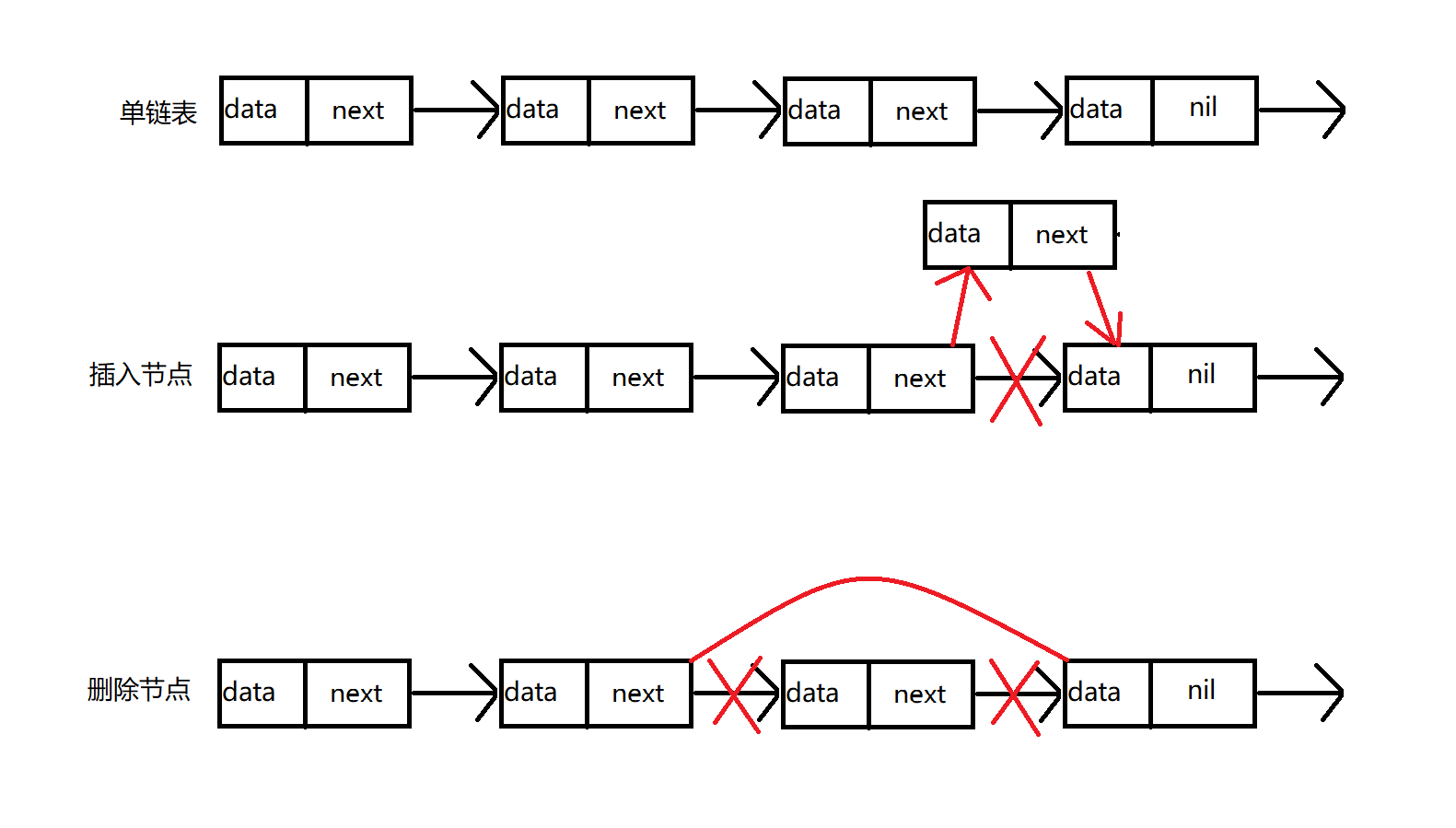单向链表、双向链表、循环链表。数据域和指针域,上一个结点的指针指向下一结点,依次相连,形成链表。
struct 定义的三种形式,其中2和3都是返回结构体的指针
//定义
var stu Student
var stu *Student = new(Student)
var stu *Student = &Student {}
//调用
stu.Name stu.Age stu.Score
或
(*stu).Name (*stu).Age (*stu).Score
定义一个单项链表next 是指针类型的属性,指向 Student struct 类型数据,也就是下一个节点的数据类型
type Student struct {
Name string
Age int
Score float32
next *Student
}
为链表赋值,并遍历链表中的每个节点
package main
import "fmt"
type Student struct {
Name string
Age int
Score float32
next *Student //存放下一个结构体的地址,用*直接指向下一个结构体
}
func main() {
//头部结构体
var head Student
head.Name = "张三"
head.Age = 28
head.Score = 88
//第二个结构体节点
var stu1 Student
stu1.Name = "李四"
stu1.Age = 25
stu1.Score = 100
head.next = &stu1
//第三个结构体节点
var stu2 Student
stu2.Name = "王五"
stu2.Age = 18
stu2.Score = 60
stu1.next = &stu2
Req(&head)
}
func Req(tmp *Student) { //tmp指针是指向下一个结构体的地址,加*就是下一个结构体
for tmp != nil { //遍历输出链表中每个结构体,判断是否为空
fmt.Println(*tmp)
tmp = tmp.next //tmp变更为下一个结构体地址
}
}
//输出结果如下
{张三 28 88 0xc000114480}
{李四 25 100 0xc0001144b0}
{王五 18 60 <nil>}
package main
import (
"fmt"
"math/rand"
)
type Student struct {
Name string
Age int
Score float32
next *Student
}
func main() {
//头部结构体
var head Student
head.Name = "head"
head.Age = 28
head.Score = 88
//第二个结构体节点
var stu1 Student
stu1.Name = "stu1"
stu1.Age = 25
stu1.Score = 100
head.next = &stu1 //头部指向第一个结构体
//第三个结构体节点
var stu2 Student
stu2.Name = "stu2"
stu2.Age = 18
stu2.Score = 60
stu1.next = &stu2 //第一个结构体指向第二个结构体
//第四个结构体节点
var stu3 Student
stu3.Name = "stu3"
stu3.Age = 18
stu3.Score = 80
stu2.next = &stu3 //第二个结构体指向第三个结构体
//声明变量
var tail = &stu3
for i := 4; i < 10; i++ {
//定义节点
var stu Student = Student{
Name: fmt.Sprintf("stu%d", i),
Age: rand.Intn(100),
Score: rand.Float32() * 100,
}
//生产结构体串联
tail.next = &stu
tail = &stu
}
Req(&head)
}
func Req(tmp *Student) {
for tmp != nil {
fmt.Println(*tmp)
tmp = tmp.next
}
}
//输出结果如下
{head 28 88 0xc0001144b0}
{stu1 25 100 0xc0001144e0}
{stu2 18 60 0xc000114510}
{stu3 18 80 0xc000114540}
{stu4 81 94.05091 0xc000114570}
{stu5 47 43.77142 0xc0001145a0}
{stu6 81 68.682304 0xc0001145d0}
{stu7 25 15.651925 0xc000114600}
{stu8 56 30.091187 0xc000114630}
{stu9 94 81.36399 <nil>}
方法二,使用函数进行优化
package main
import (
"fmt"
"math/rand"
)
type Student struct {
Name string
Age int
Score float32
next *Student
}
func main() {
//头部结构体
var head Student
head.Name = "head"
head.Age = 28
head.Score = 88
TailInsert(&head)
Req(&head)
}
//循环遍历
func Req(tmp *Student) {
for tmp != nil {
fmt.Println(*tmp)
tmp = tmp.next
}
}
//添加结构体节点
func TailInsert(tail *Student) {
for i := 0; i < 10; i++ {
//定义节点
var stu Student = Student{
Name: fmt.Sprintf("stu%d", i),
Age: rand.Intn(100),
Score: rand.Float32() * 100,
}
//生产结构体串联
tail.next = &stu //指向下一个结构体
tail = &stu //把当前的结构体给tail,让其继续循环
}
}
//输出结果如下
{head 28 88 0xc0001144b0}
{stu0 81 94.05091 0xc0001144e0}
{stu1 47 43.77142 0xc000114510}
{stu2 81 68.682304 0xc000114540}
{stu3 25 15.651925 0xc000114570}
{stu4 56 30.091187 0xc0001145a0}
{stu5 94 81.36399 0xc0001145d0}
{stu6 62 38.06572 0xc000114600}
{stu7 28 46.888985 0xc000114630}
{stu8 11 29.310184 0xc000114660}
{stu9 37 21.855305 <nil>}
package main
import (
"fmt"
"math/rand"
)
type Student struct {
Name string
Age int
Score float32
next *Student
}
func main() {
//头部结构体
var head Student
head.Name = "head"
head.Age = 28
head.Score = 88
//调用头部插入函数
HeadInsert(&head)
Req(HeadInsert(&head))
func Req(tmp *Student) {
for tmp != nil {
fmt.Println(*tmp)
tmp = tmp.next
}
func HeadInsert(p *Student) *Student {
for i := 0; i < 10; i++ {
var stu = Student{
Name: fmt.Sprintf("stu%d", i),
Age: rand.Intn(100),
Score: rand.Float32() * 100,
}
//当前新节点指向head,因为head是下一个节点
stu.next = p //指向下一个节点
p = &stu //把当前的结构体给tail,让其继续循环
return p
//输出结果如下
{stu9 85 30.152267 0xc000094840}
{stu8 37 5.912065 0xc000094810}
{stu7 29 7.9453626 0xc0000947e0}
{stu6 87 60.72534 0xc0000947b0}
{stu5 41 2.8303082 0xc000094780}
{stu4 90 69.67192 0xc000094750}
{stu3 87 20.658266 0xc000094720}
{stu2 47 29.708258 0xc0000946f0}
{stu1 28 86.249146 0xc0000946c0}
{stu0 95 36.08714 0xc0000944b0}
{head 28 88 <nil>}

方法二
使用指针的指针
package main
import (
"fmt"
"math/rand"
)
type Student struct {
Name string
Age int
Score float32
next *Student
}
func main() {
//头部结构体
var head *Student = &Student{}
head.Name = "head"
head.Age = 28
head.Score = 88
//调用头部插入函数
HeadInsert(&head)
Req(head)
func Req(tmp *Student) {
for tmp != nil {
fmt.Println(*tmp)
tmp = tmp.next
}
func HeadInsert(p **Student) {
for i := 0; i < 10; i++ {
var stu = Student{
Name: fmt.Sprintf("stu%d", i),
Age: rand.Intn(100),
Score: rand.Float32() * 100,
}
//当前新节点指向head,因为head是下一个节点
stu.next = *p //指向下一个节点
*p = &stu //把当前的结构体给tail,让其继续循环
//输出结果如下
{stu9 37 21.855305 0xc000114660}
{stu8 11 29.310184 0xc000114630}
{stu7 28 46.888985 0xc000114600}
{stu6 62 38.06572 0xc0001145d0}
{stu5 94 81.36399 0xc0001145a0}
{stu4 56 30.091187 0xc000114570}
{stu3 25 15.651925 0xc000114540}
{stu2 81 68.682304 0xc000114510}
{stu1 47 43.77142 0xc0001144e0}
{stu0 81 94.05091 0xc0001144b0}
{head 28 88 <nil>}
总结
如果想要外部的数据和函数处理结果进行同步,两种方法:
① 传参,传递指针
② return 进行值的返回
package main
import (
"fmt"
"math/rand"
)
type Student struct {
Name string
Age int
Score float32
next *Student
}
func main() {
//头部结构体
var head *Student = &Student{} //定义指针类型
head.Name = "head"
head.Age = 28
head.Score = 88
//定义新的节点
var newNode *Student = &Student{} //定义指针类型
newNode.Name = "newNode"
newNode.Age = 19
newNode.Score = 78
HeadInsert(&head)
//指定位置插入函数
Add(head, newNode)
Req(head)
func Req(tmp *Student) {
for tmp != nil {
fmt.Println(*tmp)
tmp = tmp.next
}
func HeadInsert(p **Student) { //传入指针的指针
for i := 0; i < 10; i++ {
var stu = Student{
Name: fmt.Sprintf("stu%d", i),
Age: rand.Intn(100),
Score: rand.Float32() * 100,
}
//当前新节点指向head,因为head是下一个节点
stu.next = *p //指向下一个节点
*p = &stu //把当前的结构体给tail,让其继续循环
//p为当前节点,newnode为插入的节点
func Add(p *Student, newNode *Student) {
for p != nil {
if p.Name == "stu6" {
//对接下一个节点
newNode.next = p.next
p.next = newNode
//插入节点指向下一个节点
p = p.next //p.next赋予给p,继续进行循环遍历
//输出结果如下
{stu9 37 21.855305 0xc0000c0660}
{stu8 11 29.310184 0xc0000c0630}
{stu7 28 46.888985 0xc0000c0600}
{stu6 62 38.06572 0xc0000c04b0}
{newNode 19 78 0xc0000c05d0}
{stu5 94 81.36399 0xc0000c05a0}
{stu4 56 30.091187 0xc0000c0570}
{stu3 25 15.651925 0xc0000c0540}
{stu2 81 68.682304 0xc0000c0510}
{stu1 47 43.77142 0xc0000c04e0}
{stu0 81 94.05091 0xc0000c0480}
{head 28 88 <nil>}
package main
import (
"fmt"
"math/rand"
)
type Student struct {
Name string
Age int
Score float32
next *Student
}
func main() {
//头部结构体
var head *Student = &Student{} //定义指针类型
head.Name = "head"
head.Age = 28
head.Score = 88
//定义新的节点
var newNode *Student = &Student{} //定义指针类型
newNode.Name = "newNode"
newNode.Age = 19
newNode.Score = 78
HeadInsert(&head)
//指定位置插入函数
Add(head, newNode)
//删除节点
del(head)
Req(head)
func Req(tmp *Student) {
for tmp != nil {
fmt.Println(*tmp)
tmp = tmp.next
}
func HeadInsert(p **Student) { //传入指针的指针
for i := 0; i < 10; i++ {
var stu = Student{
Name: fmt.Sprintf("stu%d", i),
Age: rand.Intn(100),
Score: rand.Float32() * 100,
}
//当前新节点指向head,因为head是下一个节点
stu.next = *p //指向下一个节点
*p = &stu //把当前的结构体给tail,让其继续循环
//p为当前节点,newnode为插入的节点
func Add(p *Student, newNode *Student) {
for p != nil {
if p.Name == "stu6" {
//对接下一个节点
newNode.next = p.next
p.next = newNode
//插入节点指向下一个节点
p = p.next //p.next赋予给p,继续进行循环遍历
//删除节点
func del(p *Student) {
var prev *Student = p //p=head prev=head ——》prev=p
if p.Name == "newNode" {
prev.next = p.next
break
prev = p //进行平移,前节点赋值
p = p.next //后节点赋值
//输出结果如下
{stu9 37 21.855305 0xc0000c0660}
{stu8 11 29.310184 0xc0000c0630}
{stu7 28 46.888985 0xc0000c0600}
{stu6 62 38.06572 0xc0000c05d0}
{stu5 94 81.36399 0xc0000c05a0}
{stu4 56 30.091187 0xc0000c0570}
{stu3 25 15.651925 0xc0000c0540}
{stu2 81 68.682304 0xc0000c0510}
{stu1 47 43.77142 0xc0000c04e0}
{stu0 81 94.05091 0xc0000c0480}
{head 28 88 <nil>}





